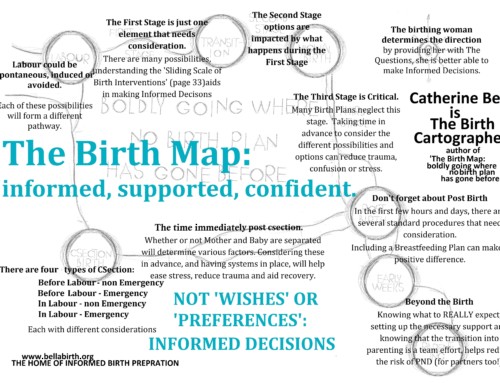By Celeste Gilman
 When I read Your Brain at Work by David Rock, all sorts of things in my life suddenly gained a new clarity of understanding. The book puts the latest brain science into the context of the types of scenarios faced on a daily basis in a typical office job. However, I gained insight into a rich diversity of life experiences. There was one experience in particular that I found myself coming back to again and again – the experience of birth. I am not a doula, midwife, or doctor, but I am a mother of two and a long-time student of the natural birth process. In this article I will show where there might be an application of brain science to birth. These are my thoughts and do not represent new research, but I believe further exploration of this connection is warranted.
When I read Your Brain at Work by David Rock, all sorts of things in my life suddenly gained a new clarity of understanding. The book puts the latest brain science into the context of the types of scenarios faced on a daily basis in a typical office job. However, I gained insight into a rich diversity of life experiences. There was one experience in particular that I found myself coming back to again and again – the experience of birth. I am not a doula, midwife, or doctor, but I am a mother of two and a long-time student of the natural birth process. In this article I will show where there might be an application of brain science to birth. These are my thoughts and do not represent new research, but I believe further exploration of this connection is warranted.
Deactivating the Pre-Frontal Cortex
Just as your pre-frontal cortex does not control the beating of your heart, but thoughts and activities in that part of your brain can lead to changes in the pace of your heartbeat, your pre-frontal cortex is not the director in labor and birth. In fact, could arousal of the pre-frontal cortex be disruptive to the natural birth process? You can deactivate the pre-frontal cortex by activating other large parts of the brain:
“One example is to focus your attention on the sounds around you, which activates brain regions involved in perceiving information coming into the senses. You could also activate the motor cortex, by doing anything physical, such as going for a walk, which makes oxygen and glucose flow to more activated areas of the brain such as the motor cortex” (p67)
This suggests that one of the ways that movement, music, and an appealing sensory environment support the natural birth process is they help reduce arousal of the pre-frontal cortex.
Creating a Positive Birth Experience
The birth of a child is one of the most pivotal, powerful moments in a woman’s life – a true right of passage. How can we prepare the woman, and her partner, to grow, become stronger, more confident, and resilient through the pregnancy and birth experience? How can we support a positive birth experience that can transcend the uncertainty of how any one particular birth may unfold? The science of mindfulness may be a powerful tool:
“Mindfulness is used by scientists today to define the experience of paying close attention, to the present, in an open and accepting way. It’s the idea of living ‘in the present,’ of being aware of experience as it occurs in real time, and accepting what you see.” (p89-90)
Current research is finding remarkable benefits to physical and emotional health associated with mindfulness:
“A person who was aware of his internal experience seemed to heal from a tough operation faster than someone who wasn’t.” (p90)
Mindfulness may be tool to speed the birth recovery, whether the birth was natural or surgical:
“Studies by Mark Williams at Oxford University found that the recurrence of depression could be decreased by 75 percent with mindfulness training.” (p91)
Given the prevalence of post-partum depression, mindfulness training could help new families get off on the right track:
“The mindfulness group had almost 50 percent greater immune function on average, based on saliva samples. Cortisol levels were also lower in the mindfulness group.” (p91)
Mindfulness may offer benefits for each step of the process, from pregnancy through birth and into the post-partum period. Scientists have found there are two mental networks in the brain. One is known as the default or narrative network. This is where we spend most of our time and it involves thinking about the past and future, planning, daydreaming, and ascribing meaning to the world. The other network is the direct experience network:
“When you focus your attention on incoming data, such as the feeling of the water in your hands while you wash up, it reduces activation of your narrative circuitry. This explains why, for example, if your narrative circuitry is going crazy worrying about an upcoming stressful event, it helps to take a deep breath and focus on the present moment. All your senses “come alive” at that moment.” (p93-94)
Birth is a natural, physiological process, but our perceptions and fears can create blocks to that process. Given the high degree of birth fear in our society, having tools to deactivate the narrative circuitry, where the fear resides, could have a powerful impact.
Opening Toward, Not Constricting Away
Dr Evian Gordon and Lea Williams have put forward the theory “that the brain has an overarching organizing principle, which is to classify the world around you into things that will either hurt you or help you stay alive” (p105). We open toward those things our limbic systems classify as helping us survive and pull away from those things that our limbic system classifies as a threat to our survival. The toward and away responses do not trigger the limbic system in the same way. Danger is perceived more intensely and “arousal from a danger also comes on faster, lasts longer, and is harder to budge” (p107). Natural birth is arguably the most opening experience in a woman’s life – her body must literally open wide enough to allow the passage of a baby. What impact does the triggering of an away response have on a woman’s ability to open in this way? Many women approach the birth experience from a place of fear – fed by everything from media portrayals to horror stories shared by people they know. The hospital setting and procedures can pile on to this baseline of fear – unfamiliar surroundings and invasive or restrictive procedures can make woman feel more threatened and farther from an opening frame of mind. What aspects of the typical birth experience are not simply neutral, but actively trigger a threat response and what impact does this have on labor progress?
Fortunately, we are not at the mercy of our limbic system. With appropriate awareness we can take steps to minimize the threat response and improve the chances of a toward response. Before an emotion is triggered, choices can be made in terms of “situation selection, situation modification, and attention deployment” (p111). For example, a mother can choose a birthing environment that puts her most at ease – that’s situation selection. Even if she can’t be in her preferred birth environment, she can modify the environment she is in to make it more comfortable, such as by playing relaxing music or adjusting the lighting level – this is situation modification. If the environment could trigger a threat response for the mother, she can still seek to avoid arousing the away response by focusing on something reassuring, such as the face of a loving and supportive birth companion – this is attention deployment. Remember, these three strategies are for before the limbic system is aroused.
Other strategies apply after a threat response has been triggered. These include expression, symbolic labeling, and reappraisal. Expression provides a form of release, and mothers should be supported to cry and fully express whatever they are feeling without inhibition. Symbolic labeling is a powerful tool that can be used both during the birth process and after birth to help heal from any negative emotions from the experience:
“To reduce arousal, you need to use just a few words to describe an emotion, and ideally use symbolic language, which means using indirect metaphors, metrics, and simplifications of your experience.” (p114)
Using just a word or two to describe an emotion helps to reduce that emotion.
Finally, cognitive reappraisal offers an even stronger tool than labeling. Neuroscientist Kevin Ochsner explains “the one thing you can always do is control your interpretation of the meaning of the situation, and that’s fundamentally what reappraisal is all about” (p126). Reappraisal has a further four forms: reinterpreting, normalizing, reordering, repositioning. Reinterpreting involves deciding something perceived as threatening is no longer threatening. When a mother understands the birth process and recognizes that the hardest part of labor signals transition and the eminent change to the pushing stage, if she starts to feel fearful about the intensity of labor she can reinterpret that experience as evidence of how powerful her body it is and how capable it is of birthing her baby. Normalizing is also in action in this example. The mother understood what she was experiencing was normal, even if it was a new experience for her:
“Having an explanation for an experience reduces uncertainty and increases a perception of control.” (p128)
Reordering refers to a shift in where one idea is positioned relative to other ideas in the nested hierarchies of the brain:
“Reordering how you value the world changes the hierarchical structure of how your brain stores information, which changes how your brain interacts with the world.” (p129)
A mother may have difficulty surrendering to the labor process if she places a high value on modesty or projecting a lady-like image. She can be supported in raising up the value of listening to her body and moving in the ways and making the sounds that come naturally to help her better cope with the experience. The last type of reappraisal involves seeing a situation from another perspective. This could be from another person’s perspective – as the baby: ‘as long as I’m doing well I would be more comfortable having labor proceed naturally without the extra force of Pitocin augmented contractions, I would like to be alert when I meet my mama for the first time, and I absolutely want to be in her arms and nursing at her breast as soon as I complete all the hard work of being born’. This could be from another culture’s perspective – many cultures view birth as normal physiological process that should unfold on its own schedule and not as a life threatening disease to be carefully managed. Or this could be from one’s own perspective at a different time – as the mother I may be challenged now by my experience of labor but I know how empowered I will feel when I have successfully birthed my baby and am holding her in my arms.
In my examples I have been focusing on the mother, but these are tools available to everyone involved in the birth experience and tools that a laboring mother is likely to need significant help employing if she can employ them during the intensity of birth:
“Reappraisal is metabolically expensive… The effort involved in reappraisal explains why it tends to be easier to reappraise with someone else.” (p133)
Reappraisal also becomes easier with practice. This can be used in preparation for birth – in a sense preprogramming useful reappraisals of the challenges likely to be encountered. Finally, humor can provide a form of reappraisal that shifts the limbic system from an away response to a toward response with very little effort.
What to Expect about Expectations
Expectations alter our perception of experience:
“Positive expectations are all about sensing that an event or item of ‘value’ is heading your way. Value in the brain, of course, means something that will help you survive.” (p140)
In other words, positive expectations stimulate the toward, opening response; conversely, “unmet expectations often create a threat response” (p141), or an away and constricting response. Based on culture, media, and personal experience, different women approach childbirth with very different expectations. Birth is also a process with significant uncertainty. No one can know in advance how a particular birth will unfold. How can this knowledge be used to help women set expectations that will best facilitate the natural progress of labor and a positive birth experience, but still be resilient enough to help a mother respond to and accept a birth that does not follow the path she had hoped? For example, is it helpful to set goals for birth?
“Another example of a self-created map for something of value is when you set a ‘goal’… Heading toward a goal can activate an overall toward state in the brain.” (p141)
A goal could support labor by stimulating a toward response. But if the goal goes unrealized, that would trigger a threat response. Can goals be set to thread this needle of risk and reward? For example, goals such as “I will make choices in birth that best protect the safety of mother and child based on the information available at the time each decision needs to be made,” or “I will focus on love and gratitude for my body, my baby, and my care team and surround myself with support people who can help me keep this focus however my birth unfolds.”
What about negative expectations of birth?
“Because expectations alter perception, this leads people to see what they expect to see, and not see what they are not expecting.” (p141)
How much does fear and expectation of negative experiences – of pain, of being judged, of loss of control, of physical harm to mother or baby – alter the hormonal balance in a way that increases the perception of pain and hinders labor progress?
“Because the brain is built to avoid threat, people tend to work hard to reinterpret events to meet their expectations.” (p141)
Do mothers who approach birth with fear interpret their experience in a way that validates their expectation that they should be fearful – avoiding the perceived threat of unmet expectations but increasing the objective physical and psychological threat of their birth?
A study by Dr. Don Price, involving blowing up a balloon in the rectum of people with irritable bowel syndrome with no medication, the anesthetic lidocaine, or a placebo, found that when “the placebo group was told they had been given ‘Something known to powerfully reduce pain in most people'” they experienced less pain than the group who received the anesthetic. What powerful implications could this have for pain management during labor? How could birth attendants utilize the power of expectations to help more mothers birth without the risks and hormonal disruptions of pain medication? Another study by Professor Robert Coghill produced analogous results. Coghill concluded that “positive expectations produce a reduction in perceived pain that rivals the effects of a clearly analgesic dose of morphine” (p144). Furthermore these changes in experience due to different expectations generated changes in brain activity:
“Expect something good, or bad, and it impacts the activation of brain regions the same as the actual experience would when generated in ‘reality’.” (p144)
Could this be part of the neuroscience behind the effectiveness of relaxation and birth preparation techniques such as Hypnobabies? How many women approach childbirth with the expectation that it will involve great suffering that they must be rescued from and what impact does that expectation have on their experience of pain?
Professor Wolfram Schultz of Cambridge University in England studies the links between the reward circuitry of the brain and dopamine:
“Shultz found that when a cue from the environment indicates you’re going to get a reward, dopamine is released in response. Unexpected rewards release more dopamine than expected ones… However, if you are expecting a reward and don’t get it, dopamine levels fall steeply. This feeling is not a pleasant one; it feels like a lot of pain.” (p144-145)
Welcoming your baby to the world is one of the greatest rewards in life. But if a birth does not unfold the way a mother expected, she doesn’t feel respected, or she feels that things are being done to her without her control or consent, what impact does that have to her dopamine levels and her experience of pain? Not only that, but how might dropping dopamine levels even impact the progression of labor?
“Dopamine is central to the toward state, to being open, curious, and interested.” (p145)
If the hormones of a toward response facilitate the birth process, then the level of dopamine could have a significant impact on labor in addition to the obvious impact on the quality of the mother’s experience. Fortunately, we don’t have to be at the mercy of expectations. Expectations can be managed through awareness of them:
“Unmet expectations are one of the important experiences to avoid, as these generate the stronger threat response.” (p147)
Positive expectations unmet can have a very negative impact. Given the great uncertainty of birth, surrendering to however the birth may unfold to ensure a healthy baby and a healthy mama is an important expectation for mothers to set. At the same time, negative expectations can become self fulfilling prophesies. Can a mother’s expectation that she can handle the intensity of contractions provide pain relief whereas her expectation that she won’t be able to cope make it more likely she will experience pain more intensely?
“As well as making sure you keep your expectations low, another way to boost your mood is to pay additional attention to positive expectations you know will be met for sure.” (p148)
Keeping focused on the moment that will come when a mother gets to meet her baby for the first time may help improve her labor experience:
“Choosing to focus on things always getting a little better, even with evidence at times to the contrary, helps you maintain a good level of dopamine.” (p148)
Can an understanding of the labor process, especially knowledge that the most intense time usually signals that dilation is almost complete and pushing will soon begin, help mothers maintain an expectation that things will get better?
“The dynamic between expectations altering experience and impacting dopamine levels, helps generate an upward or downward spiral in the brain.” (p151)
How can care providers help mothers dynamically manage expectations, to help them maintain or regain a toward response?
The Importance of Feeling Connected
“A feeling of relatedness is a primary reward for the brain, and an absence of relatedness generates a primary threat.” (p159)
Mammals are not designed to birth when they feel threatened. For the birthing mother to feel connected to all people who are in her presence is likely very important to her ability to feel safe and open toward birth. In general, people are impacted by the emotions and intentions of the people around them. Birthing mothers may be even more susceptible to this effect. Mirror neurons in the brain give us direct experience of an intentional act we observe another person making:
“Christian Keyser, a leading mirror neuron researcher based in Holland, says, . . . ’What happens is that when we witness others’ facial expressions, we activate the same in our own motor cortex, but we also transmit this information to the insula, involved in our emotions. When I see your facial expression, I get the movement of your face, which drives the same motor response on my face, so a smile gets a smile. The motor resonance is also sent on to your own emotional centers, so you share the emotion of the person in front of you’.” (p160)
If emotions are contagious between people in normal times, it seems especially important in the vulnerable time of birth that the people around a birthing mother consistently project confidence in her, support and caring, peace, and patience.
“Studies show that the strongest emotion in a team can ripple out and drive everyone to resonate with the same emotion, without anyone consciously knowing this is happening. . . . Mirror neurons explain why leaders need to be extra conscious of managing their stress levels, as their emotions really do impact others.” (p161)
This suggests that everyone on the care team should be conscious of the emotions they are projecting, with the person with the most authority maintaining a heightened awareness. The hospital environment, where a mother can expect to know very few if any of her care team in advance of arriving in labor, provides an added challenge to helping mothers feel connected, and therefore safe, in their place of birth:
“Just as the brain automatically classifies any situation into a possible reward or threat, it does the same with people, determining, subconsciously, whether each person you meet is either a friend or foe.” (p162)
“You use one set of brain circuits for thinking about people who you believe are like you, who you feel are friends, and a different set for those whom you view as different from you, as foes. When your brain decides someone is a friend, you process your interactions using a similar part of the brain you use for thinking about your own experience. Deciding someone is a friend also generates a toward emotional response. . . . When you interconnect your thoughts, emotions, and goals with other people, you release oxytocin, a pleasurable chemical. It’s the same chemical experience that a small child gets when he makes physical contact with his mother, from the moment of birth onward. Oxytocin is released when two people dance together, play music together, or engage in collaborative conversation. It’s the neurochemistry of safe connectivity.” (p162)
Oxytocin is one of the most critical hormones of birth. The normal, natural progress of labor is dependent on ample oxytocin. This suggests that care should be taken to help mothers connect with each person on the care team as a perceived friend. It should not be taken for granted that this will occur:
“Our animal instincts seem to naturally cause us to withdraw and treat others as foes, unless a situation arises that generates oxytocin.” (p163)
Oxytocin release could be stimulated by encouraging the mother and the care team to engage in activities that foster feelings of connection, ensuring that time is taken on the first meeting to establish a personal connection and sense of rapport, and consistently interacting in a way that stimulates oxytocin, such as engaging in respectful, supportive conversation and loving touch (being touched gently, slow dancing with a partner, being massaged or held). If the mother feels well supported by the people around her, this could not only stimulate oxytocin, which helps labor progress, but reduce cortisol, which can hinder labor progress:
“Increased social support also serves as a buffer against potential stresses by reducing reactivity to other threats… Naomi Eisenberger, a social neuroscientist at UCLA, . . . explains: ‘[people with greater levels of social support] seem to be less stress responsive. They even produce less cortisol’.” (p164)
This observation may explain some of the findings that women who are supported by a doula throughout labor are more likely to have a shorter labor and less likely to have a surgical birth than those who are not. The continuous social support provided by the doula could facilitate the labor process by increasing oxytocin and reducing cortisol.
Being Treated Fairly and Respectfully
A woman in labor, particularly one entering a medical setting, is vulnerable on many levels. Her body is going through a powerful process it may never have been through before that she is not able to control or direct. This process will most likely lead to a healthy outcome for her and her baby, but even in the best case her life and how she relates to others will be profoundly changed. While a positive outcome is likely, the possibility exists that her baby or herself may not complete the process alive or undamaged. Add to this the unfamiliarity of a medical setting and the powerful position of medical staff, and you have a scenario that is ripe with triggers for the mother to experience a lack of fairness and a threat to her status.
Fairness and status are two of the primary social rewards/threats (along with certainty, autonomy, and relatedness). A woman may experience a fairness threat because of physical processes occurring that are outside of anyone’s control or because of the actions of her care team or others around her. As her fatigue increases, she may be particularly susceptible to these triggers:
“Since unfairness packs a hefty punch, it’s easy to get upset by small injustices when you’re tired, or when your limbic system already has a strong base load of arousal.” (p176)
A sensitive care team can help a woman minimize a fairness threat responses in many ways. They can start by listening to her concerns and preferences and flexing their approach in response. For example, if a mother does not want a saline-lock, nursing staff could talk with her about her fears, offer suggestions that have worked well for other mothers, and suggest they wait until a later time to place the saline-lock rather than rushing to do it right away as a matter of protocol. The care team can also help the mother to reframe her experience so that it feels less unfair, especially when circumstances cannot be changed. If a mother feels like she has lost control of her birth, either because of the intensity of labor or because a surgical birth is necessary, affirming her incredible strength and that she is doing everything right to help her baby be born the way it needs to be born, could help her to accept rather than rebel against the situation. When a mother feels fairly treated, there appear to be hormonal benefits:
“On the plus side, fairness is hedonically rewarding, activating dopamine cells deep in the brain the way a good meal or an unexpected bonus at work might do. When you experience a fair response, it’s likely that serotonin, a neurotransmitter that puts you at ease, increases, although no studies have yet shown this directly.” (p177)
In fact, a feeling of fairness stimulates that all-important birth hormone, oxytocin:
“The feeling you get from a sense of fairness is one of connecting safely with others, so it’s linked to relatedness. When you feel someone is being fair, there is a feeling of increased trust. . . . Oxytocin levels increase in fair exchanges, too.” (p177)
It’s likely that there is a significant interaction between perceived fairness and expectations:
“If you expect someone to be fair with you and they are, you get a nice positive dopamine high, for two reasons: first, from your expectations being met, and second, from the fairness itself.” (p179)
On the other hand, if “you expect someone to be fair with you and they are not, you get a double negative: a significant dopamine low from the expectations not being met, and from the unfairness. This may explain why the arousal is so strong when someone trusted . . . is unfair to you. Now you’ve got the ‘perfect storm’ of arousal, a triple whammy. This experience also has a word . . . betrayal. A feeling of even mild betrayal can be a very intense experience” (p179). Heading into birth, a woman has put her trust into her care and support teams to help her bring her baby into the world safely and lovingly. If she feels she is treated unfairly in the process, the strength of the negative experience may stay with her long after the birth. Like feelings of unfairness, a perceived decrease in status is experienced as a primary threat:
“A perceived threat to status feels as if it could come with terrible consequences. The response can be visceral, including a flood of cortisol to the blood and a rush of resources to the limbic system that inhibit clear thinking.” (p189)
Cortisol is counterproductive to labor. Many women report receiving significant positive attention while pregnant, but that while they are in the midst of doing the hard work of birthing their baby that all focus seems to shift to the baby and they are left feeling unacknowledged in the background. Women’s deference to medical personnel can also decrease their sense of relative status:
“A feeling of being less than other people activates the same brain regions as physical pain.” (p190)
If a drop in perceived status can generate a rush of cortisol and activate the same regions of the brain as physical pain, then could triggering a perceived drop in status in a laboring woman make it significantly harder for her to cope with labor? The care team should be particularly sensitive to status as a primary reward/threat, as interactions with the laboring woman and her family could also trigger a perceived status threat among the care team. For example, it may feel difficult sometimes to truly listen to the woman’s concerns and preferences, if they run contrary to the understanding of members of the care team. However, when either party has a closed mind to the perspective and understanding of the other, it can lock the pair into a battle for status.
“When you decide you are right, the other person must be wrong, which means you don’t listen to what she says, and she experiences you as a threat, too.” (p191)
It is important for the mother to feel central to the decisions around her care. If she feels excluded, her emotional/hormonal reaction can be strong:
“Naomi Eisenberger, a leading social neuroscience researcher at UCLA . . . says, ‘What we found is that when people were excluded, you see activity in the dorsal portion of the anterior cingulate cortex, which is the neural region that’s also involved in the distressing component of pain, or what sometimes people call the ‘suffering component’ of pain’.” (p189)
How much might a perceived drop in status increase a laboring woman’s perceived pain and increase her feeling of suffering? With awareness, the care team can avoid inadvertent contests of status and focus on supporting the mother to maintain or grow her own perceived status:
“An increase in status is one of the world’s greatest feelings. Dopamine and serotonin levels go up, linked to feeling happier, and cortisol levels go down, a marker of lower stress.” (p192)
Could the hormonal reactions to an increased sense of status help the natural unfolding of labor? Increasing status can be done relatively easily:
“Giving people positive feedback, pointing out what they do well, gives others a sense of increasing status, especially when done publicly.” (p194)
While the laboring mother can receive significant benefit from those around her helping her to maintain or increase her sense of status, she can also directly increase her own sense of status through her interpretation of how she is doing:
“Because we perceive ourselves using the same circuits we use when perceiving others, you can trick your brain into a status reward by playing against yourself.” (p199)
Self praise, acknowledgement, and appreciation appears to have some of the same benefits of acknowledgement from others. This is likely most effective when the mother and her team are unified in their approach and probably hard to maintain if the words and actions of the care team run contrary to what the mother is telling herself.
What Does This Mean for Maternity Care?
The insights gained recently from neuroscience about the fundamental operation of our brains are fascinating. In this article, I have proposed some ideas, from a lay perspective, of how these insights might apply to the process of birth. I am not a neuroscientist or a doctor, simply a person who cares a great deal about how we can help mothers and babies have the best births possible. My hope is that this article will stimulate research into these topics as well as give mothers and care providers food for thought about how they might use insights from neuroscience to foster birth experiences that are positive and best support the natural unfolding of birth.
 Celeste Gilman lives with her two daughters and husband in Seattle, WA. She was born at home and has been fascinated by natural pregnancy, birth, and parenting for as long as she can remember. She greatly enjoys getting to be a participant and not just an armchair admirer of the parenting adventure – unexpected challenges, moments of grace, and all.[/fusion_builder_column][/fusion_builder_row][/fusion_builder_container]
Celeste Gilman lives with her two daughters and husband in Seattle, WA. She was born at home and has been fascinated by natural pregnancy, birth, and parenting for as long as she can remember. She greatly enjoys getting to be a participant and not just an armchair admirer of the parenting adventure – unexpected challenges, moments of grace, and all.[/fusion_builder_column][/fusion_builder_row][/fusion_builder_container]






Really truly enjoyed this post. Thank you for articulating these concepts so well, while addressing the emotional, spiritual and natural (almost holistic) aspects of parenthood in a scientific way. I am a 29 year old girl/woman, pre-pregnancy, trying to assuage my feelings of anxiety about it all before we actually take the plunge. This post is one of the few, rare ones that helped. Thank you.
What a wonderful article! So much resonates with my GentleBirth program – ‘Brain Training for Birth’. What’s happening in the brain is just as important as what’s happening in the body (if not more important) and we have so much more influence on how it works in labor than we think. As a midwife the neuroplasticity of the maternal brain was not part of my training – and I doubt if it is now. Helping mothers change their relationship to stress in pregnancy is also ‘training’ their unborn baby’s responses too as our baby’s environment (cortisol or endorphins/oxytocin) changes the architecture of the unborn baby’s brain.
Thank you for sharing your insights!
Tracy